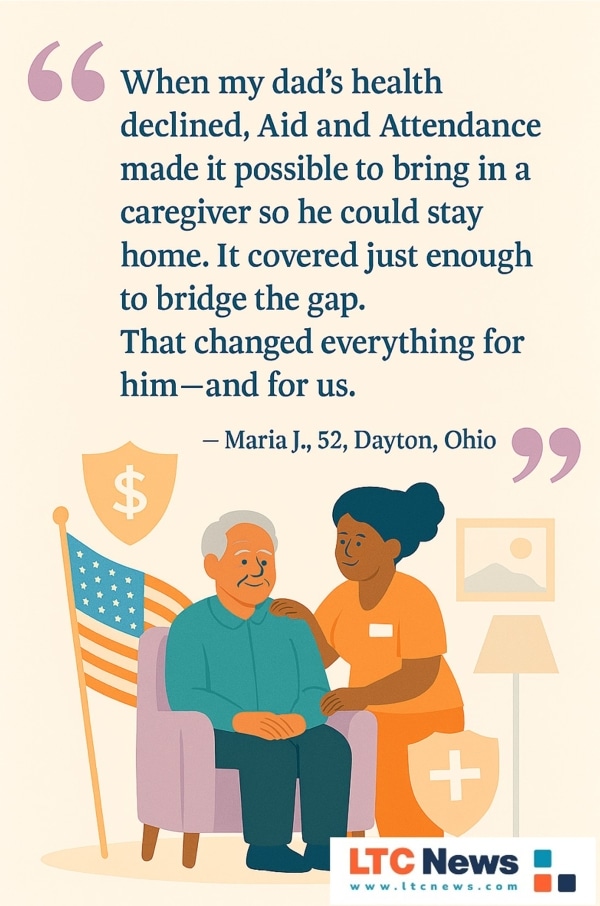VA Aid and Attendance: A Vet's Guide to Paying for Extended Care

You may be caring for a spouse or parent who now needs help with bathing, dressing, or meals. You worry about safety. You also worry about cost. Aid and Attendance can help cover in-home care, assisted living, or nursing home care if you qualify for a VA pension. This article explains the rules in plain English so you can take action with confidence.
- Editor’s note: This article is for educational purposes only. It does not provide legal, tax, medical, or financial advice. Always consult an accredited VA representative or other qualified professional.
Across the country, veterans make up about 6.1 percent of the adult population. In some states, including Alaska and Virginia, the share is even higher.
Many of these veterans are aging in place, and as they need more support, families are forced to make tough care decisions. Aid and Attendance can provide real relief — if you know how to navigate the system.
What Aid and Attendance Covers
Aid and Attendance is a monthly financial benefit paid in addition to a VA Pension or Survivors' Pension. It is designed for veterans and surviving spouses who need regular assistance with daily activities, have severe vision limitations, are mostly bedridden, or are living in a nursing home.
The payment is not restricted to a specific use, but many families apply it to:
- In-home caregiver services
- Assisted living and memory care
- Nursing home costs that are not covered by other sources
You cannot receive Aid and Attendance and Housebound benefits at the same time.
- Learn more about extended care costs in your state with the LTC News Cost of Care Calculator.
If necessary, experienced law firms specializing in veterans' law can play a crucial role. Chisholm Chisholm & Kilpatrick LTD (CCK Law) says the right firm can help veterans and surviving spouses understand how Aid and Attendance works and how it can serve as a financial lifeline for those who need daily care.
By linking broad veteran demographics to the program’s eligibility and financial structure, these advocates help families move from complex rules and statistics to real, personal relief for those who qualify.
Who Qualifies for Aid and Attendance
To receive Aid and Attendance, a veteran must first meet VA pension eligibility criteria:
Service Requirement:
- Active duty before September 8, 1980 → at least 90 days of active duty, with at least one day during a wartime period.
- Active duty after September 7, 1980 → generally at least 24 months or the full call-up period, with at least one day during a wartime period.
Medical Requirement:
One of the following must apply:
- You need help with activities of daily living such as bathing, dressing, or eating.
- You are largely confined to bed due to illness.
- You reside in a nursing home due to disability.
- You have significant vision loss (5/200 visual acuity or worse in both eyes, or severe visual field restriction).
Financial Requirement:
Your income and net worth must fall below VA limits after allowable medical deductions.
Wartime periods include:
World War II, Korea, Vietnam, and the Gulf War (which remains ongoing as of October 2025).
2025 Aid and Attendance Benefit Amounts (MAPRs)
| Status | Annual MAPR |
| Veteran with Aid and Attendance | $28,300 |
| Veteran with one dependent | $33,548 |
| Two veterans married (both on A&A) | $44,886 |
| Surviving spouse with Aid and Attendance | $18,187 |
| Surviving spouse with one dependent | $21,696 |
Source: VA MAPR Tables, as of October 2025
- Why this matters: If your income, after deducting unreimbursed medical expenses, is below these thresholds, the VA may pay the difference.
Net Worth and the 3-Year Look-Back
As of 2025:
- Net worth limit: $159,240 (includes income + assets; excludes primary residence and vehicle).
- Look-back period: 3 years from the date the claim is received.
- Penalty divisor: $2,795 per month.
- Penalty cap: 5 years.
If the VA finds assets were transferred below fair market value during the look-back period, they may apply a penalty period during which benefits will not be paid.
Deducting Medical Expenses to Qualify
You may lower your countable income by reporting unreimbursed medical expenses. These include:
- Caregiver or home care agency costs
- Assisted living and nursing home expenses (if medically necessary)
- Medicare premiums and supplemental insurance premiums
- Medical supplies and services
These expenses are reported on VA Form 21P-8416, and only the amount exceeding 5% of the applicable MAPR is deducted.
How to Apply for Aid and Attendance
Step 1: Gather Medical Documentation
- VA Form 21-2680 (Examination for Housebound Status or Permanent Need for Regular Aid and Attendance) completed by your healthcare provider.
- VA Form 21-0779 if the veteran is in a nursing home.
Step 2: Complete the Pension Application
- Veterans use VA Form 21P-527EZ.
- Surviving spouses use VA Form 21P-534EZ.
Step 3: Submit Medical Expense Records
Step 4: Protect Your Effective Date
- If you need more time, file an Intent to File using VA Form 21-0966. This holds your place for up to one year and can make benefits retroactive.
Step 5: Mail or File Online
Mail applications to:
Department of Veterans Affairs
Pension Intake Center
P.O. Box 5365
Janesville, WI 53547-5365
Get Free Help — Do Not Pay for Claims Assistance
You should never have to pay someone to file an Aid and Attendance claim. Accredited organizations like the Disabled American Veterans (DAV), County Veteran Service Officers (CVSOs), and other VA-accredited representatives can help you complete forms, gather evidence, and track your claim.
No veteran should start the claims process by paying for representation. Accredited VSOs provide free support from start to finish. — DAV statement, Sept. 2025
Find accredited representatives through the VA accreditation search.
A&A vs. Housebound Benefits
Aid and Attendance is for veterans who need daily hands-on help or meet the vision or nursing home criteria. Housebound is for veterans who have a permanent disability that keeps them mostly at home. You cannot receive both benefits at the same time.
Real Impact on Families
This benefit doesn’t just pay bills. It helps aging veterans maintain their dignity and gives families breathing room when they need it most.

Share your thoughts and experiences about aging, caregiving, health, retirement, and long-term care with LTC News —Contact LTC News.
Your Next Steps
- Check eligibility — review service, medical, and financial requirements.
- Get the medical form completed early to avoid delays.
- File an Intent to File if you’re still gathering records.
- Contact a VSO for no-cost help.
- Search for caregivers and long-term care facilities.
- Compare local extended care costs with your potential benefit.


